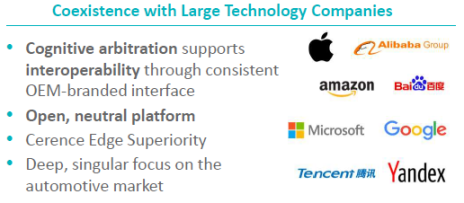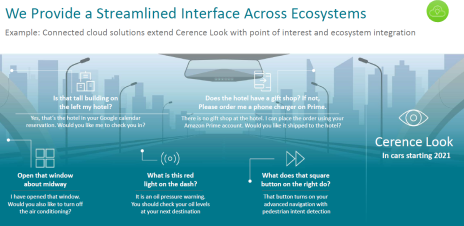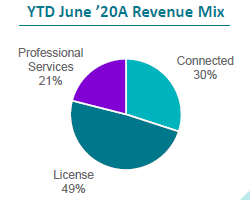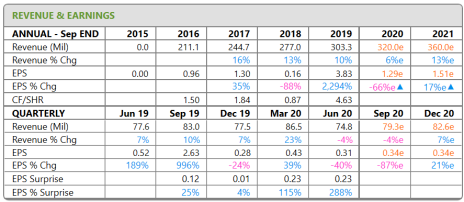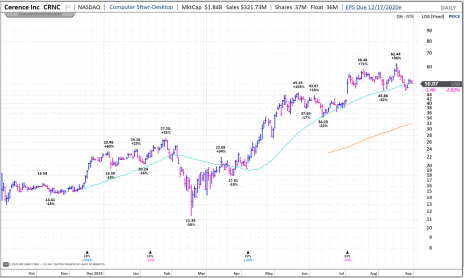While automobiles have become more consumer-friendly over the last decade there are still a lot of clunky technologies that drivers deal with.
Sometimes mobile devices pair seamlessly, sometimes they don’t. Sometimes, a car’s infotainment system functions so poorly that drivers are more distracted than they were in the good old days of reaching for cassette tapes under the passenger seat.
Today we’re investing in a company that’s developing a digital ecosystem for connected and autonomous vehicles that will make driving safer and more enjoyable for everyone.
It’s an under-the-radar story still, but not for long. Enjoy!
Cabot Small Cap Confidential 257
[premium_html_toc post_id="216822"]
The Big Idea
It wasn’t long ago that the only items you’d bring in your car to improve the user experience were tapes and CDs. Maybe you had a dash-mounted GPS unit. These things either worked or they didn’t. There wasn’t too much messing around.
How times have changed. Today, when you climb in the driver’s seat you have an entire digital life in the palm of your hand. Phone, text, stories, podcasts, restaurant reviews, and so on are available at the touch of a few buttons.
The downside to all this power is that messing around on a mobile device can be a tremendous distraction and create bad driving habits, or worse.
The obvious solution has been for auto manufacturers to develop infotainment systems that integrate the most used consumer applications into the car itself. The holy grail is to make things work perfectly with voice-activated prompts.
Cars are getting better, but there’s still a lot of room for improvement. Many cars that are only a few years old offer clunky and fragmented experiences driven by poor technology integrations. This only serves to frustrate drivers and cause the same distraction issue that existed when they were messing around on a mobile device.
On the other hand, some auto manufacturers have really stepped up their game and offer relatively powerful and slick infotainments systems that truly differentiate their brand and models from the competition.
In many cases the car itself is connected to the cloud so it can access data and information when needed, without relying on a connection from a mobile device. While roughly 45% of all cars produced in 2020 are expected to have designed-in connected services, industry analysts think the percentage will jump to 60% by 2024.
Consumers are taking notice. Today, technology is often one of the deciding factors in a car purchase decision.
Consumers are increasingly reliant on a host of virtual assistants to access and control their digital lives, and they’re looking for that in their cars too. Hands-free access to automotive AI solutions is becoming central to the driving experience.
Today we’re investing in the market leader in AI-powered digital assistants for the automotive market. It’s a newly independent company that sees growth accelerating as market demand for its solutions grows.
The Company
Cerence (CRNC) develops market-leading, AI-powered digital assistants and other technologies for connected and autonomous vehicles. Its solutions are the most widely adopted in the global auto market and are aimed at delivering what all drivers want – a simple and intuitive hands-free connected car experience.
This means no fumbling around with myriad mobile devices or switching between different operating systems to access parts of our digital lives.
Cerence’s platform aims to connect drivers to all the technologies in their digital world through one common user interface. Virtual assistants are accessed through natural and intuitive human-vehicle interactions, including speech, touch, handwriting, gaze tracking and gestures.
Accessible technologies run the gamut, from navigation, text, and phone to entertainment, to ignition on-off. The company is even working on a hands-free payment solution.
The company believes its software platform and virtual assistants can become the digital soul for cars, thereby fostering deeper and more intuitive connections with drivers, while making driving safer and more enjoyable for everyone.
The platform, which is delivered on a white-label basis so auto makers can tweak it to suit their brand, is technology agnostic. It supports integration of many third-party solutions, such as those from Apple, Amazon and Google, and funnels them all through one consistent user interface that is jointly designed by Cerence and the auto manufacturer.
The company, which has a market cap of $1.8 billion, has a deep history spanning two decades of speech and language technology development. Until last October Cerence was a division within Nuance Communications (NUAN), which spun it out into a pure-play automotive-specific company. Nuance remains focused on its healthcare and enterprise businesses today.
The spin has given Cerence the autonomy and resources to better pursue its mission of empowering a digital ecosystem for connected and autonomous vehicles.
It’s making great progress. Cerence’s platform is the market leader for integrated, branded virtual assistance for automobiles.
Customer count tops 65 and spans all the major auto OEMs, including BMW, Daimler, Ford, GM, Toyota, Volkswagen, FCA Group and Ford. Approximately 40% of revenue comes from the OEMS.
Tier-1 suppliers represent another large customer group from which Cerence derived 60% of fiscal 2019 revenue. Tier-1 customers include Bosch, Aptiv, Harman, DENSO TEN, Continental and more.
Altogether, there are now more than 325 million cars with Cerence technology. That’s roughly one in every two cars in the world. In fiscal 2019 (ended September 30), Cerence was placed in over 48 million vehicles, which amounts to roughly 52% of all vehicles shipped. That’s an increase from 37% in 2018.
It’s not a super fast-growing business yet, as it’s very much in transition and investment mode. Revenue in fiscal 2019, Cerence’s last year as part of Nuance, was up 9.5%. Revenue growth this fiscal year (which ended yesterday) should be around 6%. Management’s five-year average revenue growth target of 15% annually implies significant acceleration in the upcoming three years.
Products & Platform
Cerence’s core offering is its software platform, which customers use to build virtual assistants that can communicate, find information, and take action across many dimensions, including:
- Navigation – points of interest, restaurants, etc.
- Control – HVAC, audio control, car status, etc.
- Media – Online music, podcasts, radio, etc.
- Communication – Calling, messaging, email, calendar, etc.
- Information – Car manual, weather, flight status, sports, etc.
- Tools – Calculator, currency converter, date/time, etc.
How does it work?
Typically, a driver issues a voice request. The software platform then determines what was said and what the intent was, then maps the request to the most relevant category.
Depending on the response needed the platform will either respond directly or access an external data source or third-party virtual assistant. Behind the scenes, Cerence uses cognitive arbitration technology to determine which of the users’ integrated technologies is best suited to address their request. In all cases there will either be an audio response or an action taken.
In order to process so many different types of requests Cerence’s platform is built with hybrid architecture that includes edge software components, which are integrated within a vehicle’s onboard system, and cloud-connected components, which tap into external networks.
The edge software attempts to process requests first so network costs are reduced. Use of edge software also allows for programming of “wake-up” words, which helps Cerence’s systems avoid the privacy issues that accompany always-on cloud-connected solutions.
When needed, requests are processed simultaneously at the edge and in the cloud. This turns the car into something resembling a rolling smartphone. Cloud accessibility allows for continued innovation as software updates can be downloaded.
Here are notes on a few of Cerence’s newer driver-facing solutions:
Cerence Reader: Cerence Reader brings a human-like virtual newscaster into the car, complete with natural pausing, breathing and content-appropriate emotional tones. The cloud-only solution is designed into cars for reading news, current events, sports and other types of long-form reading.
Cerence Pay: Cerence Pay allows the driver to authenticate payments from the car using just his or her voice. The secure, contactless payment system is intended for use at gas stations, parking meters, take-out food and coffee shops, and other locations where this type of solution can make life better for drivers.
Cerence Life: Cerence Life is a suite of AI-powered SaaS offerings that are tailored to individual cars and that help drive a closer connection between owner and automobile. This could mean communications in the early days of car ownership about how to use it, AI-powered service scheduling, and alerts on software updates.
Growth Initiatives
Expand From Premium To Entry-Level: Cerence’s most advanced solutions are in high-end cars, but there remains a huge opportunity to bring more content to mid- and lower-priced vehicles, as well as older cars that lack AI-powered assistants altogether. Management will be updating investors on progress moving down market over the coming year.
Develop Adjacent Markets: Cerence sees opportunity to break into new markets and is aggressively pursuing them. It has recently landed bookings in two adjacent markets, including two-wheel vehicles and tractors. Expect more news on this front, as well as potential moves into non-vehicle markets where voice recognition tech can play a role.
Layer Additional Applications: Cerence estimates that by 2024 it can generate $75 million (13% of company total) in annual revenue from a new SaaS product that will produce annual recurring revenue. Solutions such as Car Life, Car Pay, cabin monitoring, voice clone, and data brokerage and monetization are all on the list.
The Business Model
Cerence generates revenue from selling software licenses (49% of revenue), cloud-connected services (30% of revenue), and professional services (21% of revenue). Connected services closely resemble SaaS revenue generated on a subscription basis.
As the company advances as an independent entity there will be some shifting of the revenue base. This is largely due to legacy connected service contracts that are winding down under an old pricing model coupled with the growth in newer SaaS revenue that is recurring in nature.
Altogether, roughly half of revenue is tied directly to quarterly new car production, while the other half is generated from cars that have already shipped and from professional services for solutions that are slated for cars that won’t hit production for several years.
The company has existing relationships with all major OEMs or their tier-1 suppliers. Contracts are typically multi-year engagements, meaning Cerence has good revenue visibility. Products are marketed via a high-touch OEM solutions model with dedicated sales teams, account managers, etc., maintaining close relationships with customers.
The Bottom Line
Because Cerence is a spin-out, the company’s financial statements aren’t as clean as they might otherwise be if it were had been an independent company for longer. Recall that the spin-out was completed on October 1, 2019 and the company’s fiscal year ends on September 30. That means Cerence’s fiscal 2019 report reflects results as a division within Nuance. Since then, it has reported three quarters as an independent entity.
With that disclosure stated, the company reported that revenue grew by 9.5% to $303 million in fiscal 2019. Adjusted EPS was 3.83 and was significantly boosted by the spin-out.
Over the first three quarters of fiscal 2020 Cerence has delivered revenue growth of 7%, 23% and -4%, respectively. Adjusted EPS has been $0.28, $0.43, and $0.31, respectively. The company beat expectations on the top line in two of the three quarters and beat on EPS in all three.
In the most recent quarter (Q3 fiscal 2020), which ended on June 30, revenue dipped 4% to $74.8 million, beating by $13.4 million. Despite the revenue dip it was an impressive quarter given the impact of Covid-19 around the world and that light vehicle sales were down roughly 45% over the same period of time. Adjusted EPS of $0.31 beat by $0.23.
In Q3 management credited the company’s connected services (SaaS revenue) for much of its resiliency. It wasn’t a fluke; management also reported the second highest bookings quarter in the company’s history as several significant strategic customer wins were closed. Quarter-ending bookings were $1.36 billion. New SaaS products, including Car Life and Cerence Pay, are expected to help drive transaction-based revenue in the coming years.
Cerence also refinanced its debt ($267 million at quarter end), resulting in an estimated $10 million in annual interest expenses. It ended the quarter with $133 million in cash and cash equivalents.
Looking forward, analysts expect Cerence’s Q4 (ended yesterday) revenue will be down modestly, resulting in fiscal 2020 revenue of $320 million, up 6%. Adjusted EPS in Q4 is expected to be $0.34, implying full-year EPS of $1.29.
Moving into its second full year as an independent company (fiscal 2021), we should expect at least 13% revenue growth, to $360 million. Management has stated it expects to average 15% annual revenue growth through fiscal 2024 so 2021 growth could be higher. Growth should accelerate into fiscal 2022. Adjusted EPS in fiscal 2021 is seen growing by around 17%, to $1.51. Cash flows are expected to move up meaningfully as legacy contracts wind down and Cerence reduces debt.
Risk
Reliance on Toyota: Toyota represented 21% of revenue in fiscal 2019. Should anything happen in this relationship it could have an adverse impact on revenue.
Competition from Large Tech Firms: As noted below in Competition, consumers are increasingly used to virtual assistants from companies like Apple, Amazon, Google and Microsoft. Should these companies make a meaningful push into the auto market Cerence could suffer.
Auto Industry Fluctuations: Today Cerence is essentially a pure-play auto-focused company. While it could diversify in the future, clearly the auto market needs to remain somewhat robust for the company to thrive.
Strategy To Grow Cloud Services: Cerence is placing a bet that cars will become increasingly connected to the cloud in the future. Should this trend reverse some of its strategic bets could fall short of expectations.
Competition
Cerence faces competition from two primary groups of companies. First are the large tech companies that offer virtual assistants, including Apple, Microsoft, Amazon, Google, Tencent, Baidu and Alibaba. Consumers are increasingly reliant on solutions from these companies and like to use them in their cars. Note the adoption of Apple CarPlay from some auto manufacturers. While these companies can be viewed as competitors, most of the solutions are made for mobile devices, not cars. Moreover, access to all virtual assistants users might want requires integrations into one user interface that’s designed for the audio environment of a specific car model. That’s what Cerence offers.
The second group of competitors are smaller companies doing more-or-less exactly what Cerence does. These include SoundHound in the U.S. and iFlyTek in China.
The Stock
Trading Volume: CRNC trades an average of 847,000 shares daily. Heavy days are over 2 million shares and there have been eight of those in the last six months.
Historical Price: CRNC was spun out from NUAN at around 15 last October and after a couple months of little action shares advanced to 27 by the end of February 2020. The market’s crash pulled CRNC down to 11.4 but shares were quick to return to their spin-out price and then broke out to fresh all-time highs in convincing fashion on June 1. A rally to 45 faded in June and CRNC consolidated in the 34 to 44 range through the end of July. The Q3 earnings report triggered a blastoff rally on August 4 that carried the stock over 50. Since then shares have been consolidating, mostly in the 47 to 58 range, with a few spikes/dips higher/lower.
Valuation & Projected Price Target: CRNC trades with a fiscal 2021 EV/Revenue multiple near 5.3. The multiple should be able to creep up into the 8 to 10 range as revenue growth accelerates, recurring revenue becomes a larger part of the mix, debt comes down, and profit margins expand. If we assume fiscal 2022 revenue grows by 20% and the multiple expands to 9, shares of CRNC are an easy double. However, let’s start with a price target of 77 by the end of calendar year 2021, which implies 50% upside from here.
Buy Range: In the near-term look to buy in the established trading range of 47 to 58. Average in and look to make bigger purchases in the high 40s and smaller ones in the mid-to-high 50s
The Next Event: Fourth-quarter fiscal 2020 earnings are expected around December 15. Prior to then management should reveal updates on new product introductions.
Updates on Current Recommendations
| Stock Name | Date Bought | Price Bought | Price on 10/1/20 | Profit | Rating |
| Accolade (ACCD) | 8/6/20 | 40.09 | 38.87 | -3% | Buy a Half |
| AppFolio (APPF) | 6/2/17 | 30.45 | 141.81 | 366% | Hold |
| Arena Pharmaceuticals (ARNA) | 2/2/18 | 38.93 | 74.79 | 92% | Buy |
| Avalara (AVLR) | 2/1/19 | 40.05 | 127.34 | 218% | Hold |
| Cardlytics Inc (CDLX) | 9/6/19 | 37.97 | 70.57 | 86% | Buy |
| Everbridge (EVBG) | 12/2/16 | 15.51 | 125.73 | 711% | Hold |
| EverQuote (EVER) | 6/7/19 | 11.69 | 38.64 | 231% | Buy |
| Fiverr Intl (FVRR) | 3/5/20 | 32.32 | 138.98 | 330% | Hold 3/4 |
| Goosehead Insurance (GSHD) | 9/7/18 | 31.35 | 86.59 | 176% | Hold 3/4 |
| Inspire Medical (INSP) | 10/4/19 | 58.54 | 129.05 | 120% | Buy |
| Karyopharm Therapeutics (KPTI) | 5/7/20 | 19.49 | 14.60 | -25% | Hold |
| Palomar Holdings (PLMR) | 6/4/20 | 82.34 | 104.24 | 27% | Buy |
| Q2 Holdings (QTWO) | 4/1/16 | 23.81 | 91.26 | 283% | Buy |
| Repay Holdings (RPAY) | 7/2/20 | 25.04 | 23.50 | -6% | Buy |
| Repligen (RGEN) | 11/2/18 and 12/31/18 | 59.19 | 147.54 | 149% | Buy |
| Sprout Social (SPT) | 9/3/20 | 36.48 | 38.50 | 6% | Buy |
Please email me at tyler@cabotwealth.com with any questions or comments about any of our stocks, or anything else on your mind.
Glossary
Buy means accumulate shares at or around the current price.
Hold means just that; hold what you have. Don’t buy, or sell, shares.
Sell means the original reasons for buying the stock no longer apply, and I recommend exiting the position.
Sell a Half means it’s time to take partial profits. Sell half (or whatever portion feels right to you) to lock in a gain, and hold on to the rest until another ratings change is issued.
The next Cabot Small-Cap Confidential issue is scheduled for November 5, 2020.
Cabot Wealth Network
Publishing independent investment advice since 1970.
CEO & Chief Investment Strategist: Timothy Lutts
President & Publisher: Ed Coburn
176 North Street, PO Box 2049, Salem, MA 01970 USA
800-326-8826 | support@cabotwealth.com | CabotWealth.com
Copyright © 2020. All rights reserved. Copying or electronic transmission of this information is a violation of copyright law. For the protection of our subscribers, copyright violations will result in immediate termination of all subscriptions without refund. No Conflicts: Cabot Wealth Network exists to serve you, our readers. We derive 100% of our revenue, or close to it, from selling subscriptions to its publications. Neither Cabot Wealth Network nor our employees are compensated in any way by the companies whose stocks we recommend or providers of associated financial services. Disclaimer: Sources of information are believed to be reliable but they are not guaranteed to be complete or error-free. Recommendations, opinions or suggestions are given with the understanding that subscribers acting on information assume all risks involved. Buy/Sell Recommendations: All recommendations are made in regular issues or email alerts or updates and posted on the private subscriber web page. Performance: The performance of this portfolio is determined using the midpoint of the high and low on the day following the recommendation. Cabot’s policy is to sell any stock that shows a loss of 20% in a bull market or 15% in a bear market from the original purchase price, calculated using the current closing price. Subscribers should apply loss limits based on their own personal purchase prices.

